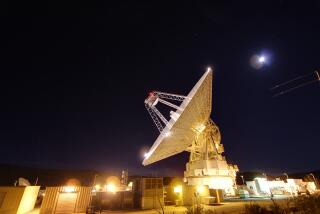Smithsonian exhibits our neglect
THE SMITHSONIAN Institution, our national museum and also a scientific research complex, is at a crisis point. Many of its 20 venues, such as the National Museum of Natural History and the National Air and Space Museum, need tens of millions of dollars in work. Desperate for funds, the Smithsonian has made arguably improper arrangements with big business, and it has accepted funding from corporations with an all-too-obvious interest in what goes on view in the institution’s museums. But the real crisis is this: Congress seems to have barely noticed.
How bad is the situation? Last year, the Government Accountability Office, a bureaucracy not given to hyperbole, found “major structural deterioration” in Smithsonian buildings and “chronic leaks.” At least two historic aircraft at the Air and Space Museum have been water-damaged. Several buildings are rife with mold. Water has flowed into at least four museums, well before last month’s rains.
The Smithsonian recently reopened its American Art Museum and the National Portrait Gallery after a $283-million renovation. That’s a good start, but nearly every other Smithsonian museum requires some level of attention. According to the GAO, the Smithsonian will need at least $2.3 billion for building costs, anti-terrorism protection and scheduled and deferred maintenance by 2013. The problems extend beyond capital improvements to the day-to-day as well: In an attempt to lower energy costs, the Hirshhorn Museum and Sculpture Garden recently restricted hot-water use in its building.
The budget pressures have apparently weakened the Smithsonian’s ethical foundations too. The Smithsonian’s leaders and their congressional overseers are allowing too much of our national museum to be transformed into a series of pavilions where, in exchange for sponsorship money and other deals, corporations may determine what parts of the American story should be told.
Two recent examples are particularly egregious: The Smithsonian sold to CBS Corp.’s Showtime network what amounts to the right of first refusal for all documentaries dependent on Smithsonian archives or staff time. Independent historians and filmmakers howled. Congress held a hearing, threw a public tantrum, but then effectively shrugged. The deal remains intact.
One of the problems with corporate involvement is the appearance of influence in exhibition programming. Recently the National Museum of American History removed the pioneering EV1 electric car from an exhibit. Perhaps not surprisingly, the museum’s new transportation wing is being sponsored by General Motors, the same GM that has been excoriated for discontinuing the EV1 despite consumer demand for the car.
You might think that corporate sponsorship is no different from private philanthropy. The Smithsonian was built, in part, with gifts from wealthy industrialists. Yet once someone has donated a collection, his or her influence on the programming is effectively complete; the influence is reflected in what they donated. But with corporate funding -- and the possibility of more -- independence comes into question. Do we know for a fact that GM’s involvement with the Museum of American History caused the EV1 to disappear from the exhibit? No, but it’s the kind of question that shouldn’t even come into play.
Sadly, Congress hasn’t focused much on these problems. It appropriates roughly 70% of the Smithsonian’s basic annual budget; the rest comes from private and corporate donations and Smithsonian businesses, such as its magazine and stores. Infrastructure is generally a separate matter. As the GAO said: “It remains unclear ... the extent to which the Smithsonian will secure the funding to carry out all of its planned facilities projects.”
A particularly feeble solution came from Rep. James Moran (D-Va.), who suggested a $1 admission charge. This would raise $25 million a year -- probably just enough to cover the accounting and auditing costs associated with charging the fee in the first place.
Congress at best merely nibbles at the problem. For example, in the Smithsonian’s fiscal 2007 budget bill, there is a small “earmark” for facilities at the National Zoo. This kind of earmark also funded the American Art Museum and the National Portrait Gallery renovations, which started in 1999. Earmarks are great, but if it takes seven years to fund and build every project, 40 years would pass before the Smithsonian’s immediate needs would be met.
The question Congress should be addressing isn’t whether or not the Smithsonian could get away with an entry fee, or whether one TV deal is problematic, it is whether we’re going to have a national museum at all in the future. If an institution that saves and shares the American story in history, science, art and culture is worth having, then Congress should make sure that the Smithsonian has the infrastructure -- and the independence -- necessary to safeguard the nation’s heritage.
Recently, Sen. Charles Grassley (R-Iowa) showed an important sign of concern. He wrote a letter to the White House pointedly asking the Bush administration whether it supports Smithsonian Secretary Lawrence Small, who has overseen the corporatization of the institution. Grassley is asking the right question. Even if the Smithsonian continued down the corporate-funding path, a series of $15-million donations (the amount Boeing recently gave the Air and Space Museum) is never going to cover the $2.3-billion bill coming due. Perhaps tellingly, the White House responded to Grassley’s letter without mentioning Small -- or expressing support for him.
The Smithsonian is the nation’s museum. That means that funding it is the responsibility of the nation. We’d better do it quickly.
More to Read
The biggest entertainment stories
Get our big stories about Hollywood, film, television, music, arts, culture and more right in your inbox as soon as they publish.
You may occasionally receive promotional content from the Los Angeles Times.










